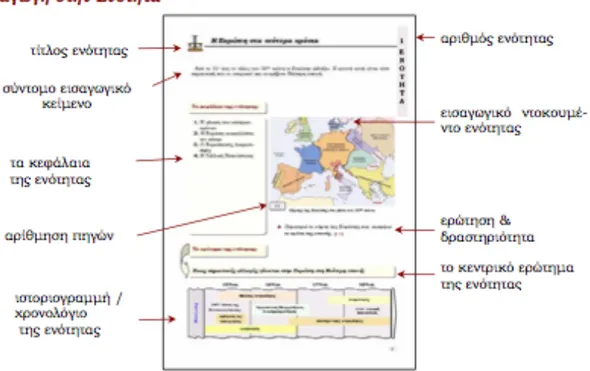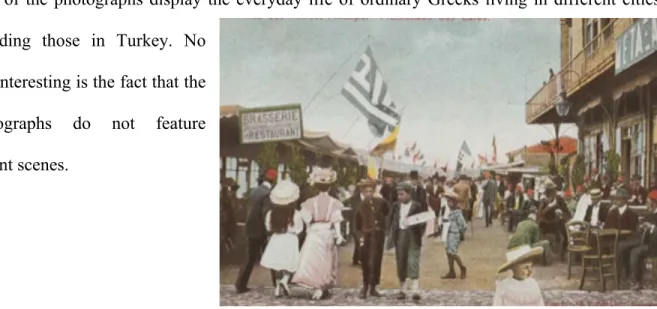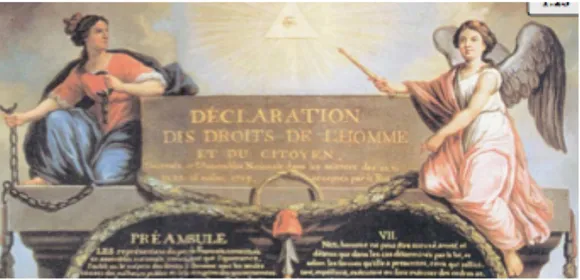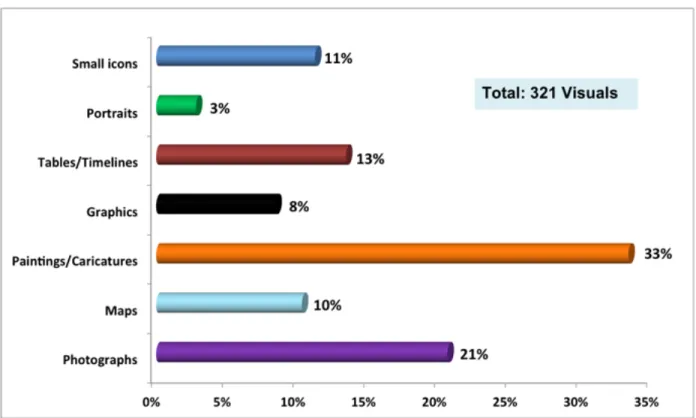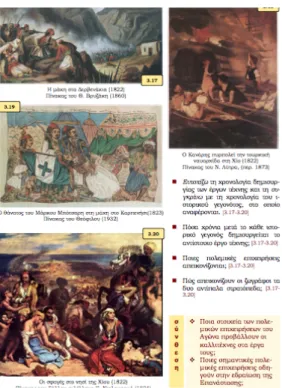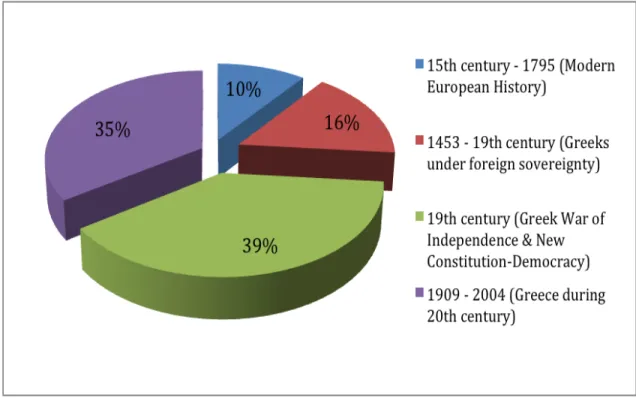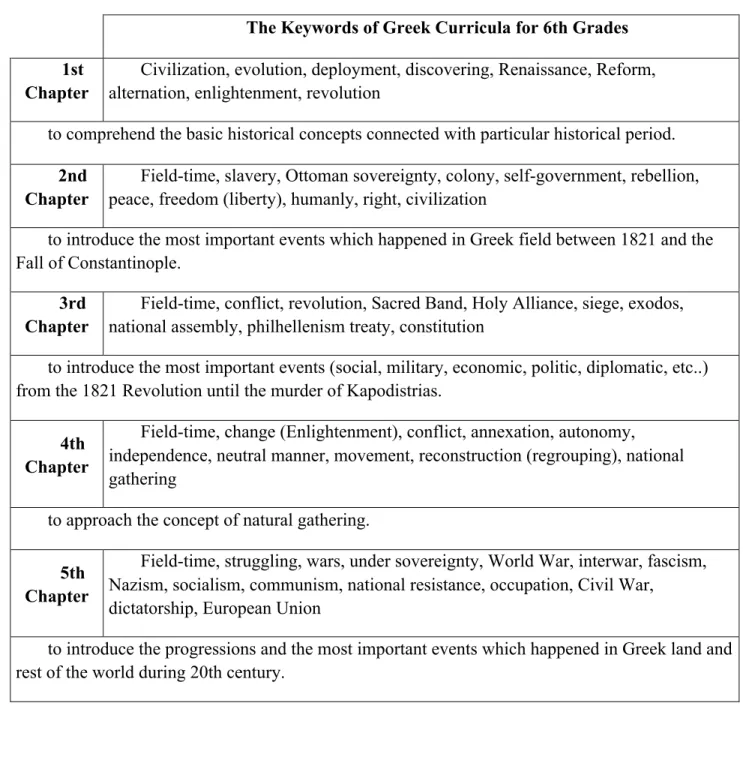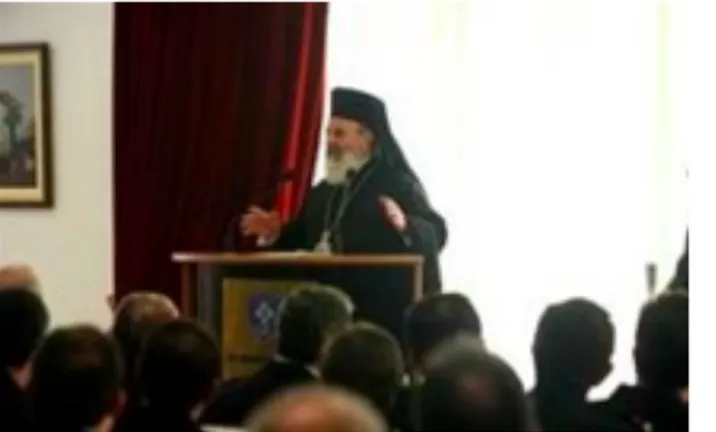Istanbul Bilgi University
Social Sciences Institute
MA Program in International Relations
Master Thesis Title:
Recent Debates on Greek History Textbooks:
The Case of Contemporary History Textbook for 6
thGrades by
Maria Repousi
EMRE METIN BILGINER
110605007
Thesis Supervisor
Prof. Dr. Gencer Özcan
ABSTRACT
The thesis aims to analyze one of the recent debates on history textbook writing in Greece. The debate the thesis will deal with was generated by the publication of a history textbook written by a group of historians led by another historian Maria Repousi. Being a sensitive issue among the public and politicians alike, common history of Greeks and Turks that lasted for centuries has always been a matter of lively debate. With a new perspective to a number of issues, Contemporary History Textbook for 6th Grades brought about a debate, which engulfed the entire Greek society. The debate surrounding the book displayed major political cleavages in the Greek society and highlighted the way leading political parties and other groupings perceived major historical issues that pertain to the common past of the two nations. After defining major characteristics of the book, the thesis focuses on the special topics that the book dealt with and eventually caused the debate, and finally takes up and discusses major arguments that the outstanding parties to the debate put forward.
ÖZET
Tez, son dönemde Yunanistan’daki tarih kitabı yazımıyla ilgili yaşanan tartışmaları analiz etmeyi amaçlamaktadır. Tezin ele alacağı tartışma, kendisi de bir tarihçi olan Maria Repousi’nin önderliğindeki bir grup tarihçi tarafından yazılan tarih kitabı yüzünden meydana geldi. Türkler ve Yunanlıların yüzyıllar boyu paylaştıkları ortak tarih, vatandaş ve politikacı gözetmeksizin herkesin gözünde hassas bir konu olagelmiş ve tartışmaların sürekli canlı kalmasına sebebiyet vermiştir. 6. Sınıflar için Modern Dönem Tarih Kitabı, yeni bakış açısının yanı sıra tartışmaları da beraberinde getirdı ve Yunan toplumunun tamamını bunun içine çekti. Kitabın etrafını kuşatan tartışma, Yunan toplumunda bir çok siyasi kırılmayı açığa çıkardı ve iktidar sahibi siyasi partiler ile birtakım grupların iki ülkenin ortak tarihindeki önemli hususları nasıl algıladığı konusuna dikkatleri çekti. Tez, kitabın başlıca niteliklerini tanımladıktan sonra içerisinde değinilen ve sonunda tartışmalara sebebiyet veren bazı özel başlıklara da odaklanıyor ve son olarak tartışmada öne sürülmüş göze çarpan önemli argümanları da gözden geçirip bunları ele alıyor.
ACKNOWLEDGMENTS
First of all, I would like to express my appreciation to my dear supervisor, Prof. Dr. Gencer Özcan, who shared all of his knowledge and became my mentor during my dissertation-writing period. Whenever I came up with a new idea, he never discouraged me. On the contrary, he tried to help me in shaping these ideas in the context of academic framework. I can easily realize my progress in writing academic research under his influence.
Gratitude to my parents, Sedef and Ercüment, not only supported me during this period, but also they let me play music as loud as I wanted. It was amazing to feel their conviction in me whenever I needed. Thanks to my grandparents, Günay and Özkan, who covered my educational needs since my childhood.
Very special thanks to Müge Doğanlar, precious girlfriend and morale booster, for caring, nursing me all the time and encouraging me with her supportive attitude during my dreadful writing process. She organized almost every single detail in order to ease my life. She also covered my lack of knowledge in using Word and Excel. I could not handle this period without her. She is indispensable.
Special thanks to my own Rock and Roll band “Merlyn” and my whole time favorite band “Queen”. They actually did not do anything for my research, but they helped me in breathing sometimes. Making and listening music leads you in stream of consciousness.
Special thanks to Burak Yetgin and Mehmet Sadık Tanış, my best friends, for their respect when I needed silence at my place during this stressful period. It was so kind that they were asking me how I was doing with my thesis almost every day.
Many thanks to Zuhal Bektaş, Ezgi Karabulut and Rena Amargianitaki for being the sisters I never had, actively supported me.
Thanks to my classmates from all over the world in this master program. I learnt so many things from each one individually.
Thanks to Stavros Gioltzoglou, my Greek language and literature professor, is the reason that I am interested in Greek history. He also helped me a lot in providing important sources about my thesis.
Thanks to Antonis Liakos, a history professor in University of Athens, for meeting me in Istanbul in a very difficult situation. It was really amazing to exchange our ideas.
Another special thanks to Anna Robertson, a good friend, who read my long sentences and corrected them for me.
Last but not least, I appreciate everyone who gave me confidence. Being there for me without expecting in return was priceless to me.
Table of Contents
Acknowledgments 5
Introduction 10
Chapter I: The Greek Historiography 13
1.1 Greek Historiography Until Today 13 1.2 Basic Rules & Regulations Concerning the Curricula 15 1.3 Banned Precedents and Major Themes 16 1.4 The Writing Process of Repousi’s Book 19
Chapter II: The Textbook 21
2.1 General Remarks 21 2.1.1 Physical Qualities 21 2.1.1.1 Size 21 2.1.1.2 Printing Features 22 2.1.2 Visuals 22 2.1.2.1 Photographs 23 2.1.2.2 Maps 24 2.1.2.3 Paintings 24 2.1.2.4 Graphics 25 2.1.2.5 Tables / Timelines 25 2.1.2.6 Portraits 25 2.1.2.7 Small Icons 26 2.2 Organization of the Book 27 2.2.1 Visual Gravity 27
2.2.2 Periodization 28
2.2.3 Study Aids 30
2.2.4 Main Foci 31
2.2.5 Keywords of the Greek Curricula 32
Chapter III: The Debate 33
3.1 Emergence of the Debate 33 3.1.1 The Beginning of the Debate 33 3.1.2 Who started it? 35 3.1.3 Rekindling of the Debate 38 3.2 Contentious Issues in the Textbook 41 3.2.1 Secret Schools (Krypho scholio) 41 3.2.2 Waterfront Throng [Synostismos] 44
3.2.3 Child Levy 46
3.3 The Evolution of the Debate 47 3.2.1 Major Parties to the Debate 47 3.2.2 Antibaro’s Impact and Their Activities 48 3.2.3 Conflict on the Rampage 49
Chapter IV: The Stalemate 53
4.1 Need for Revision 53 4.1.1 Demands for Correction 55 4.1.2 Releasing of the 2nd Edition 60
4.1.3 Major Corrections 61 4.2 Withdrawal of the Book 63 4.2.1 First Impact to the Corrections 63 4.2.2 The Withdrawal Process 64
4.3 Withering of the Debate 65 4.3.1 Why did it Wither? 65 4.3.2 Who Withered it? 66
Conclusion and Discussions 67
Introduction
The debates over the history textbooks do not obstruct the necessity of historiography. This dilemma may be a vicious circle, but it reflects the truth. Human beings’ wondering about their past does not end. There have been several researches about national histories of the countries, albeit there are already written papers. In my thesis, I tried to focus on Greek historiography and its problematic issues. Since Greece has a huge and deep history, it is a very exhausting job to re-write or revise its history. Particularly, the history narrating since the 1930s generated an inflexible perception in minds of Greek people, especially after the Civil War and military dictatorship period. Whenever someone argues new things about Greek history, it causes a national debate. In Repousi’s case, the book was exposed to countless attacks in different topics such as downplaying the role of the Greek Church during Greek Revolution, the compromising manner to the Cyprus question, the lack of Secret School issue, etc.
In only 138 pages history textbook affected the conversation topics of the daily life. As Maria Repousi’s book was introduced to the children at schools, it became the major topic in Greece. At the beginning, there was not a debate atmosphere, but everybody could smell the potential bad reactions from the nationalist bloc of the country.
The present study deals with one of the recent debates in Greek historiography. In order to comprehend the significance of this debate, it is essential to deal with the book in every sense, such as its content, its author team, its supporters, its opponents, etc. First of all, why was Repousi’s book so important to be discussed in every platform? Why did everyone need to opine over the situation? It was tried to be limited the aforementioned case with its own actors such as its writing team, political parties, media and academicians. When we consider the Greek
historiography, especially since 1974, limiting the case to its decade was so difficult. Therefore I regarded the recent past of debates as one of the factors of Repousi’s case. That is why; I gave concise history of the Greek history narrating since the period of military dictatorship in the first chapter of my thesis. In this manner, the readers of my dissertation are going to be able to compare or associate the different cases. Likewise, the previous textbook bans also have significance when we consider that most of them have more or less the same reasons to be withdrawn from publication. As we looked at the banned precedents of history textbooks since 1974, it is possible to mention that the extreme nationalist perspective took the advantage of the situation in every case. In order to convince the governments for the withdrawal of the book, it was always important to damage the reputation of the book. In this debate, also the writers of the book were on the target.
The second chapter of my work focuses on Repousi’s book in every sense. Most of the readers of my study may not be able to read the textbook since it was not translated from Greek to any language. This is why; it is essential to provide a broad introduction to the readers of my thesis in order for them to follow the debate phase with basic information. During the controversies of this book, not only the event-based content of the book was a subject of discussion, but also the distribution of contents and visuals was regarded as troublesome. In this respect, some of the prominent visuals, sentences and tables were observed individually. Thus, the readers may have a chance to discuss the debatable issues by following the book through this dissertation.
The third chapter dealt with every perspective along this recent debate. Who started the first criticisms? Who rekindled the debate? Who became the torchbearer from among the opponents of the book? These initial points are the remarkable ones to be answered in order to
conceive the whole debate. Furthermore, the most contentious issues are going to be discussed in this chapter. It is also possible to observe how the usage of some words in the book may mobilize the nationalist reflexes. The main question the debate arose was whether the parties used this textbook as a political instrument or not. Interestingly, the political parties, who have completely different ideologies gathered and stood against the book. This is why; it is strongly discussable whether only the extreme-nationalist bloc of the country used this debate as a political instrument for the upcoming general elections. Who tried to take an advantage of textbook controversies? Which parties gained votes? Which parties lost?
The fourth and final chapter of my thesis is the sequel of “The Debate” part. In this case, we can divide the controversy process into two parts as “the period until correction” and “the period until withdrawal”. The word “stalemate” defines exactly the correction process because there were too many attempts to break the deadlock from both sides of the debate and no one could manage to satisfy the other side. This impasse led the actors to take a breathe for awhile. Therefore the Ministry of Education decided to apply some corrections over the textbook in order to gratify the opponent bloc of the case. Was the correction necessary over the book or was it applied just for muting the radical noises against the book? After all of these questions, it is very difficult to skip one. What kind of correction could hinder the demands for the withdrawal of the book? Was there really any chance to meet the requests of nationalist side?
My dissertation covers a very specific case. That is why; my aim is to go straight to the point without exhausting the readers. There are some graphics and pictures to lighten the readers in a visual sense. It is also possible to find some prominent visuals from the textbook. Therefore, the book will become more deductive to discuss over it.
CHAPTER I – THE PAST OF THE GREEK
HISTORIOGRAPHY
1.1 - Greek Historiography Until Today
The history narrating has been an everlasting debate issue for decades. As Greeks have a long history, the writing of it is something, which should be done meticulously. The conjuncture of the Greek political life always had an impact over historiography. We will take a look at the remarkable periods of Greek history writing in order to comprehend the change of perceptions over the last few decades.
Before the classification of the Greek Historiography, it is better to take a quick look at the period before the 70s. In contemporary Greek history narrating, we can highlight two periods, (The Ottoman domination period and the independence of Greek State). Until the first chair in Modern History at the University of Athens in 1937, Greek history was considered as the sequel of Byzantine periods and did not focus the cases beyond the Greek Revolution period (1821-1828)1. World War II led many literary writers to work on historical studies. The Civil War years also became one of the main reasons to focus on history making in the 40s. Dimaras, one of the most important pioneers, rose the term “Greek Enlightenment’ in 1945. This might be the initial point of history wars in Greece. Antonis Liakos describes the reasons of confrontations caused by history narrating referring to the Enlightenment…
1 Antonis Liakos, Modern Greek Historiography (1974-‐2000). The Era of Tradition from
Dictatorship to Democracy, in Ulf Brunbauer (Re)Writing History. Historiography in Southeast
Europe after Socialism, Münster, LIT, Verlag (2004), p. 351-‐378
http://antonisliakos.files.wordpress.com/2011/04/historiography-‐1975-‐20002.pdf [accessed on 29 September 2012]
The concept of the Enlightenment also confronted the warring ideological frameworks of the Right and Left. It resisted the ethnocentric and romantic view of the National Revival, supported by the Right, but also, the idea that the national revolution remained incomplete as a result of the defeat of bourgeois and popular social forces, maintained by the Left.2
The sensitivity of the history narrating emerged with the ideological dichotomies between the Left and Right.
The 2nd military junta changed many things in Greece, as well as the Greek
historiography. In 1976, the Greek Government started to make a series of reforms in education. The government, on the basis of constitution of 1975, announced the nine years compulsory and free education for everyone. This situation led the education authorities to produce new textbooks.
In 1981, the general elections resulted in parliamentary power going to the socialist party PASOK. They launched a big scale of reforms between the years 1982 and 1985. The Greek education system aimed to provide the social justice with these reforms in 1980s since there was a necessity of a new perception after 1974 due to the Greek society’s transformation. Particularly, the Civil War years (1946-1949) affected the history writing, transforming it into a nationalist view. That is why; the new system tried to eliminate the conservative and extreme nationalist expressions from the textbooks by the 80s. As a result of this, a group of historians
2 Antonis Liakos, Modern Greek Historiography (1974-‐2000). The Era of Tradition from
Dictatorship to Democracy, in Ulf Brunbauer (Re)Writing History. Historiography in Southeast
Europe after Socialism, Münster, LIT, Verlag (2004), p. 351-‐378
http://antonisliakos.files.wordpress.com/2011/04/historiography-‐1975-‐20002.pdf [accessed on 29 September 2012]
who have Marxist views started to write the history textbooks.3 New Greek historiography followed the way of the ‘French’ Annales School4.
As a beginning, the history textbooks for 2nd and 3rd grades were published. Another important thing we can observe from textbook publication during the 80s is that some of those textbooks are still in circulation.
1.2 - Basic Rules & Regulations Concerning the Curricula
Earlier, the commission was writing the book and Pedagogical Institute was deciding which book would be used in curriculum. The Ministry of Education authorized the Pedagogical Institute to decide upon the selection of the textbooks to be used in schools.
Now in Greece, academicians at the universities are writing the history textbooks. There are compulsory, unique textbooks for each grade. The regulations do not allow the teachers to use some teaching aids or additional books to help their teaching method. Whereas some academicians argue that schoolbooks should be competitive; the others claim that schoolbooks cannot be the issue of competition. In the following parts, we are going to examine the different procedures, which were applied by the Ministry for the 6th grades textbook.
3 Bahar Şahin et al., Improvement of Balkan History Textbooks Project Reports, (Istanbul: Tarih
Vakfı Yurt Yayınları, 1st edition, 2002), p. 96
4 This is a French School, which established by Marxist historians during 20th century. They
focused on social scientific methods to describe the history rather than political and diplomatic themes.
In the context of textbook content, there are also some regulations. The distribution of contents is supposed to be assigned according to the curriculum. We can see the whole distribution in the “table number 1”.
CLASSES
CONTENT
Third class of primary school (8-9 years old) [Greek] mythology Forth class (9-10 years old) [Greek] Ancient History Fifth class (10-11 years old) Medieval-Byzantine History
Sixth class (11-12 years old) Modern & Contemporary [Greek] History First class of junior high school (12-13 years
old)
Ancient Greek & Roman History Second class (13-14 years old) Medieval [Greek] –Byzantine- History
Table 1 -‐ Distribution of Content5
1.3 – Banned Precedents and Major Themes
In Greek Historiography, there have been many debates over the history textbooks. These debates end with different scenarios. The opponents suggest the recall of the textbook in the first place, but sometimes the correction over the books may be a solution. In this section, we will comprehend the reasons of necessities in changing the textbooks.
5 Maria Repousi, Politics questions history education – Debates on Greek History Textbooks, in
Popp S. (ed.), Yearbook of International Society for History Didactics, 2006/2007, p. 99-‐110.
http://users.auth.gr/marrep/PS_REPOUSI/ENG/PUBLICATIONS/Politics%20questions%20history %20education%20English.pdf [accessed on 12 September 2012]
Since Greece does not have “Historical Association”, the Pedagogical Institute of Greece gathers the members of its community every 5-6 years in order to revise the History Curricula. The institution questions whether the textbook damages the public sensitivities or not. In order to take into consideration the replacement, correction or withdrawal decisions, the institution contemplates the public opinion. That is why the Pedagogical Institute collects all the criticized materials. This is the procedure over the textbook publishing, but there is another factor, which is the political conjuncture, may trigger the textbook debates. A recurrent example might be telling that in Turkish and Greek history textbooks, we can observe too many nationalist expressions. The elimination of these is due to the bilateral political progressions between Greece and Turkey. Whenever there blows winds of rapprochement, both sides are getting closer to sign bilateral agreements in order to improve the history textbooks by purifying the hostile images.
Greece implemented the main innovations and evolutions in education in 1976 just after the fall of the military dictatorship. Since 1974, the innovations sometimes caused criticism in Greece. The history narration is an extremely sensitive case, so the people can react very aggressively when they are no venerated by the history.
So far, 4 books were banned in Greece after 1974. (1986, 1988, 1998 and 2007) Two of these books were for the 10th grades. (1st grade of Lyceum) One of them was for the 12th grade, (3rd grade of Lyceum).
• History of Human Kind, 10
thgrade (1990)
The worldwide known historian, Leften Stavrianos6, wrote the book and it was published in 1984. He added the evolution theory of Darwin to his book and this was perceived as an attack to the Greek Orthodox Church.7 The book remained in circulation with some corrections until the end of the 80s, but it was finally withdrawn in 1990. The previous textbook, “History of Ancient Greece” replaced it.8
• Introduction to Historical Studies, 12
thgrade (1990)
The debate emerged with the chapter “History and its Methods”. The book and the author of it were criticized for a considerable time. That book adopted the methodological perspective provided by Annales School and so it was blamed that the book was downplaying the role of personality in history.
This book was banned also in the same year. The new right-wing government did not replace the book with another.
• The Contribution of Hellenic Civilization, 10
thgrade (1998)
This book was also on the target of the nationalist groups because it gave a considerable place to the European and world history. This was perceived as the downplaying of the values of the Greek history and banned from circulation.
6 Leften Stavrianos passed away in 2005.
7 Maria Repousi, History Textbooks Controversies in Greece, 1985-‐2008. Considerations on the
text and the context, Canadian Diversity / Diversité canadienne, vol. 7, no 1, (2009): 25-‐30.
8 Bahar Şahin et al., Improvement of Balkan History Textbooks Project Reports, (Istanbul: Tarih
1.4 - The Writing Process of Repousi’s Book
The textbook is co-authored by Hara Andreadou, Aristidis Poutahidis, Armodios Tsivas and Maria Repousi, but it is known to be Repousi’s book. Repousi was the author who led the team.
According to the rules and regulations of the Pedagogical Institute, the writers should take into consideration four essential points during the writing process: The pedagogical aims and objectives, the contents, methodological instructions evaluation. However, the author team does not have any kind of restriction such as religion, ideological, political tendencies, etc.
The writing team of the books is chosen from among the academicians and schoolteachers. They work independently, but they have to follow the instructions, which are assigned by the Pedagogical Institute.
In 2003, the Greek State made some innovations for Greek historiography and decided to change all the textbooks. The candidates for the textbook writing sent the drafts with their approximate budgets. Repousi and her team made an application only for the 6th grades textbook with 32.000-euro fund. This was the biggest amount in history textbook writing as far as its budget is concerned.9
It was decided that Repousi and her team took the authority to write the textbook. They did not have a time limitation and they started to work in 2003 and completed the book for publication in 2 years.
9 Οι νεοί φάκελοι, «Το βιβλίο» [The Book], The Greek TV documentary serial, ΣΚΑΙ 2007
Maria Repousi, the head of the team, who was a history professor in Aristotle University of Thessaloniki. Her first experience in textbook writing was the one for 6th grades and the book became a matter of debate in Greece. Now she is a
deputy of Democratic Left10 Party from Athens.
Hara Andreadou is teaching in primary education since 1990 and she is also involved in training the teachers for teaching the history in primary schools.
Aristidis Poutahidis is teaching in primary education since 1988 and participates in training programs for primary school history education.
Armodios Tsivas is a teacher for more than 20 years. He was also doctoral student in the Department of Education during the writing process of the book.
10 Δημοκρατική Αριστερά – ΔΗΜ.ΑΡ.
CHAPTER II: THE TEXTBOOK
2.1 - General Remarks
2.1.1 – Physical Qualities
2.1.1.1 - Size: Maria Repousi’s first history textbook11 for 6th grades includes 138 pages,
which makes the book different from the previous ones that were strikingly more voluminous. The length of the book became a matter of debate because the book was far shorter than had been expected. Therefore, whenever Repousi was interviewed, one of the points she made was that her textbook was concise and met the requirements set by the European Union on the size of the textbooks. In one of the interviews she gave…
The textbook has no size limitations; it has a disproportionately large amount of material. How big should a book be for a child of 11 or 12 years old who has history lessons twice a week? Other European states use shorter textbooks with fewer pages, or a larger book that is for the first three years of primary school. The problem is the vast amount of material the book must cover. It’s not the choice of writing team. It complied with the demands of the syllabus. This is something that must change to our books, our teachers and above all, our children can breathe.12
The first two pages of the textbook include the guidelines on how to use it under the title “How to follow the chapters? Where to find the sources?”
The paragraphs are short and readable so that pupils can easily comprehend the text.
11 There is also the second edition of the book.
2.1.1.2 - Printing Features: Maria Repousi’s textbook is printed on A4 format plain
paper. Some titles and pictures are colored. However, when the printing features and quality of the textbook are compared with previous ones, it does not seem to be different in a significant way.
2.1.2 – Visuals
The textbook appears to be strikingly different as far as the quantity and quality of visuals it contains. The pages are illustrated with 321 visuals. In this respect, the textbook is far more illustrated than the others published before. The visuals come in different forms: photographs, maps, paintings, graphics, tables/timelines, portraits and thumbnails.
In comparison to the previous ones, the textbook seems to be illustrated with less dramatic pictures. As it will be discussed below, the pictures chosen by the author represent less violent aspects of the Greek history and shed more light on peaceful, historic scenes. This marks a clear departure from the mainstream Greek historiography that tends to use images glorifying Greek history.
The alternative book13, which was offered by some opposing parties14, did not contain many visuals.
2.1.2.1 - Photographs: There are 66 photographs in the textbook. It is interesting that
most of the photographs display the everyday life of ordinary Greeks living in different cities, including those in Turkey. No
less interesting is the fact that the photographs do not feature violent scenes.
13 Γιάννης Σμυρνιωτάκης – Ιστορία ΣΤ’ Δημοτικού Στα Νεότερα και Σύγχρονα Χρόνια (Giannis
Smirniotakis – History at Primary School – During Modern and Contemporary Years)
14 Especially the website www.antibaro.gr challenged the Repousi’s textbook and suggested
Giannis Smirniotakis’s textbook instead.
Figure 3 -‐ Example from the alternative book of Smirniotakis
So one can argue that the impression that the photographs give is in conformity with the general narrative of the textbook that highlights the peaceful aspects of the Greek history.
2.1.2.2 – Maps: Maps may be the most effective way of history telling. The maps mostly
affect people when they follow a history textbook because maps may be hypnotizing.
There are 33 maps in the textbook. Given that the textbook is 138 pages, the amount dedicated to maps within the textbook is quite large. It is possible to find graphics, timelines or tables next to almost every map within the book. These information boxes support the efficiency of the maps.
2.1.2.3 – Paintings: The book contains 107 paintings15. Paintings in the textbook are the
most used form in the context of visuals. In Greek historiography, paintings have an important place when it comes to the mythological and national figures. It is possible to observe only one mythological figure16 at the beginning of the book. Most of the paintings were placed in the first three chapters. This means every page has almost two paintings until the 4th chapter. The
European History chapter especially, is illustrated by the well-known paintings such as Leonardo
Da Vinci’s The Vitruvian Man and xxx’s French Revolution etc. From my point of view, the minimum that writers aim to pass is the basic information and visual memory from the European history.
15 107 paintings include few engravings and caricatures as well. 16 Botticelli’s famous painting “The Birth of Venus” on the 2nd page.
2.1.2.4 – Graphics: There are 27 graphics within the book. More than half of these give
information about the population distribution from time to time. This time period corresponds to the last three chapters of the book.
2.1.2.5 - Tables / Timelines: There are 43 tables and timelines in Repousi’s book.
Generally tables are placed at the bottom of pages. Their image is like a measuring rod and gives very basic dates and information about the historical events, with colorful and chronologic orders. The dates, which are used in these timelines, also refer to the main article about the topic. Thus students are able to memorize the crucial dates from their own history.
2.1.2.6 – Portraits: There are only nine wide-sized portraits within this book. The previous
and alternative history textbooks had many more portraits when we compare. The reason for the
Figure 5 -‐ The topic "Seperation of Powers" includes several paintings, p. 12
decrease in portrait numbers is to minimize the presence of national heroes. We can observe the inclusion of only well-known actors, such as Aleksandros Mavrocordatos, Theodoros Kolokotronis, Charilaos Trikoupis and Elefterios Venizelos.
2.1.2.7 – Small icons: There are 36 small icons. Actually I planned to distribute them to
the portraits, but these pictures are very tiny and mostly placed below the page, attached to the timelines. Apart from the national figures, there are also some pictures from the daily life of the late 19th century. Most of them seem pointless due to their size.
Table 2– Distribution of visuals
2.2 – Organization of the Book
2.2.1 - Visual Gravity
In this section, I am going to focus on the gravity of the visuals in terms of their percentage in pages. As I mentioned before, almost every page contains at least one visual. On the other hand, most of the pages have more than two visuals, meaning that they cover large space in the textbook. For instance, pictures like the one seen in Figure 6 almost wholly cover 13 pages. In addition to this, the largest individual visual in the book covers more than half of
the page17. Generally speaking the visuals cover almost 30-35% of the book. Greek media
questioned whether this much gravity of the visuals was useful for the pupils or not. At first sight, it seems helpful to the children due to the manner that visuals stimulate their interest and curiosity. However, visuals of this kind seem to create some problems and debates. Without going into the details of the debate invoked by excessive use of visuals in textbooks, it is possible to argue that the visuals may undermine the children’s ability to learn history by reading. In other words, visuals somehow encourage learning through looking rather than reading which, some fear, can lead to laziness. More of this issue will be taken up in the chapter titled “The Debate”.
17 Political claims 1843-‐1862, movement of 3rd September 1843, p. 69
2.2.2 - Periodization
First of all, the name of the book is “History at Primary School – During Modern and Contemporary Years (Ιστορία ΣΤ’ Δηµοτικού – Στα νεότερα και σύγχρονα χρόνια)”. According to the curricula, the chapters should be started from the Age of Enlightenment and be followed by
the French Revolution. For the final chapter of the book, there is no timeline limit to conclude the topics. That is why we can easily observe that Repousi expands the book until the Olympic games of 2004 in Athens.
Greek Curricula advises the writers to have five chapters and suggests titles for each chapter. Having complied with the curriculum, Maria Repousi’s book does have five chapters. However, interestingly enough, the textbook does not follow the suggestion of the curriculum for
1st Chapter
Europe during modern years
14 pages 2nd Chapter
Greeks under foreign sovereignty
22 pages 3rd Chapter
The Greek Revolution of 1821
29 pages 4th Chapter
Greece becomes an independent country
22 pages
5th Chapter
Greece during 20th century
45 pages
the title of the 2nd chapter, which is “Hellenism after the Fall of Constantinople18”. The title used in the textbook is remarkably different and reflects the general tendency of the narrative adopted by the authors: “Greeks under Foreign Sovereignty.”
The first chapter of the book gives a contemporary European history in 15 pages. Then the second chapter contains general information about the Greeks under the foreign dominance for almost 20 pages. The 3rd chapter of the book is the part most worthy of attention for the Greek nationalist bloc because they always demand the writers to glorify the Greek Revolution. In this respect, this issue became the initial point of the debates over the book. In this chapter, the writers gave place to the Greek War of Independence in 1821. Although this chapter contains almost 30 pages, this amount did not satisfy the nationalist side of the country.
Table 4 - Distribution of eras
The time range that the book covers is about 250 years. It starts from the 18th century and ends in the 2000s. If we exclude the European history period, we can observe that only 39% of the book is about Greece’s Independence and Liberation War. The rest of it (35% + 16%) involves bad periods of time of the Greek people. In previous books, the gravity of the Heroism was focused on more than in this book.
2.2.3 – Study Aids
Ioannis Papagrigoriou, who is the writer of the previous book, supervised the Repousi’s book for the 6th grades. He claims that Repousi’s book introduces a new way of critical thinking with new technologies. In addition to all, he stresses that this book was written based on an “analytical programme” which was prepared by the Pedagogical Institute with detailed guidelines19. This was the requirement of the new law. Alongside the book the writing team also prepared a DVD as a teaching aid, which covers many things in the book, such as the Catastrophe of Asia Minor. However, the bureaucratic process of the Greek Government obstructed the delivery of these aids to a single school. As a result, no one could get these aids.
When you randomly open a page of the book, you immediately realize that every page has at least one picture. There are also linguistic parts that make up almost every page. These linguistic parts are a kind of glossary for the pupils. Therefore, they can learn the unknown terminology, used or referred to in the paragraphs. In addition to these glossaries, some
19 George Gilson, Battle Royal Over History Book, Athens News, 12th April 2007
prominent words, terms and names are accessible in the pages. Their explanations are given in bold characters.
2.2.4 – Main Foci
The main focus of the book is to challenge the tenets of the traditional/Orthodox Greek Historiography that is based on the idealization of what it should mean to be Greek and the victimization of Hellenism. This involves other challenges that the book put forward in different periods and different contexts. Some of the challenges concern the narratives dealing with the relations with Turks or the period under Ottoman sovereignty.
Maria Repousi aimed to encourage 11-12 year old children to think and question about their own history with her 6th grade history textbook. In order to help with this, the writing team of the book gave importance to the narrative side of it. Many bibliographies were used within the book. Maria Repousi especially tried to avoid stereotypes such as the reproduction of national and historical myths. She also put aside the idealization of what it means to be Greek and the victimization of Hellenism. She emphatically expresses that ‘history battles’20 do not take place
in her book. That is why; this determination does not limit the text with only an event-based content. This brings us to the initial discussion over the book. Usage of classical heroes in Greek history was reduced in this book compared to the previous books. Another very important aim of the book was to increase the presence of women in history.
Many people considered this word -Συνοστισµός – synostismos- 21, which was used within the book, as the main aim of the book. Co-authors of the book deemed suitable the definition of Asia Minor Catastrophe by describing it as a waterfront throng22. This problematic and new way of describing this case drew a widespread reaction from everyone. The aim of using this word was to create a new symbol for softening the dramatic common history between Turkey and Greece by writing with a light narrative and more flexible and compliant language.23
2.2.5 – Keywords of the Greek Curricula
The Greek Curriculum provides some guidelines for the textbook writers. The most important part of these guidelines is the given keywords. In the following table, it is noticeable that the keywords are distributed into every chapter. In addition to the keywords, every chapter has one sentence explanation, which emphasizes the aims of the study.
21 It means waterfront throng in Greek.
22 Especially this word rekindled the following debates over the book. 23 Antonis Liakos, History Wars: Testing tolerance, p. 17
Table 5 -‐ The keyword distribution for 6th grade textbook24
24 Διαθεματικό Ενιαίο Πλαίσιο Προγράμματων Σπουδών, p. 185-‐186
The Keywords of Greek Curricula for 6th Grades 1st
Chapter
Civilization, evolution, deployment, discovering, Renaissance, Reform, alternation, enlightenment, revolution
to comprehend the basic historical concepts connected with particular historical period.
2nd Chapter
Field-time, slavery, Ottoman sovereignty, colony, self-government, rebellion, peace, freedom (liberty), humanly, right, civilization
to introduce the most important events which happened in Greek field between 1821 and the Fall of Constantinople.
3rd Chapter
Field-time, conflict, revolution, Sacred Band, Holy Alliance, siege, exodos, national assembly, philhellenism treaty, constitution
to introduce the most important events (social, military, economic, politic, diplomatic, etc..) from the 1821 Revolution until the murder of Kapodistrias.
4th Chapter
Field-time, change (Enlightenment), conflict, annexation, autonomy, independence, neutral manner, movement, reconstruction (regrouping), national gathering
to approach the concept of natural gathering.
5th Chapter
Field-time, struggling, wars, under sovereignty, World War, interwar, fascism, Nazism, socialism, communism, national resistance, occupation, Civil War,
dictatorship, European Union
to introduce the progressions and the most important events which happened in Greek land and rest of the world during 20th century.
CHAPTER III – THE DEBATE
3.1 - Emergence of the Debate
3.1.1 - The Beginning of the Debate
Maria Repousi’s history textbook was introduced to the 6th grades in September 2006 and
controversy over the book became public in the wake of its first presentation to the media. Her textbook was presented as an innovative history book, which was written by professional historians. Although the book was co-authored by Hara Andreadou, Aristidis Poutahidis, Armodios Tsivas and Maria Repousi, and supervised by Ioannis Papagrigoriou, it was known to be as Maria Repousi’s. Its first publication came out in March 2006. Initial reactions to the book were by and large positive, and the opposite statements remained under control in 2006.
During the fall of 2006, as Minister of Education, Marietta Giannakou introduced the textbook and she faced initial critics. The critics focused on several points that the textbook raised that the Greeks had not been exposed to as much pressure from the Ottomans as the previous Greek historiography claimed to be. Likewise, the textbook had downplayed the role of the Orthodox Church during War of Independence.25 Another important accusation against the
25 “Greek-‐history textbook stirs flame”, Turkish Daily News, 18 February 2008
http://www.hurriyetdailynews.com/default.aspx?pageid=438&n=greek-‐history-‐textbook-‐stirs-‐ flame-‐2007-‐03-‐26 [accessed on 2 August 2012]
book was that it had been geared to beautify the historical background of Turkish-Greek relations26.
It is observed that the debate kept its resilience, as those who stood behind the textbook did at least in the eyes of the public, not refute the arguments against the textbook. No matter what the supporters of the book did to suspend its withdrawal, those who strove to ban the book did not step down in their efforts. Therefore, it is possible to claim that should there be such a debate again; the same circles will most probably put forward a severe resistance of a similar kind.
3.1.2 - Who Started it?
The Orthodox Church took the lead and became the torchbearer of the circles who opposed the textbook. The bishops became and remained the mouthpiece of the opposition, invoking the authorities to take action against the text. The Church claimed that the textbook aimed to belittle the extent of atrocities and brutalities that the Greeks had to suffer under the Turkokratia. The controversy was confined to the historians and academicians until Archbishop Christodoulos27, who dealt
with the issue in a speech given at the University of Athens in June 2006, galvanized it.
26 “The dispute over a Greek history book”, euro-‐topics (Neue Zürcher Zeitung), Amalia Van
Gent, 12 April 2007, Switzerland
http://www.eurotopics.net/en/home/autorenindex/autor_van_gent_amalia/ [accessed on 9 August 2012]
27 Archbishop Christodoulos passed away on 28 January 2008
Figure 7 – Archbishop Christodoulos gives a speech at the University of Athens
How can you show the children an impure history? Some European Authorities must not renounce what we are. Why should not we, the Greeks, honor the richness of our history?’ ‘We have history and tradition and it is a crime of extreme betrayal trying to abolish these things for which our fathers fought. (...) The national consciousness is inflicted and those responsible for it are seriously endangering the national
characteristics. We are about to sacrifice everything [what] the progressive forces tell us to do.28
We have got our objections. A special committee of the Church examines the voids and weaknesses and very soon we will address the Ministry.29
The new general elections were on the horizon and Archbishop Christodoulos got wide support from the nationalist bloc of the country.
The first reaction to Christodoulos’s statements
came from the New Democracy Minister of Education, Marietta Giannakou. She was emphasizing…
28 «Τι φταίνε τα παιδιά να μάθουν μια νοθευμένη ιστορία; Καμία ευρωπαϊκή εξουσία δεν μας υποχρεώνει να απαρνηθούμε αυτό που είμαστε. Γιατί εμείς οι Έλληνες να μην τιμούμε τον θησαυρό της ιστορίας μας; Έχουμε ιστορία και παράδοση και αποτελεί έγκλημα εσχάτης προδοσίας να είμαστε έτοιμοι να προσπαθήσουμε να απεμπολήσουμε αυτά για τα οποία οι πατέρες μας αγωνίστηκαν (...) Η εθνική συνείδηση πλήττεται και όποιος τολμά να μιλά κινδυνεύει να χαρακτηριστεί φονταμενταλιστής ή εθνικιστής. Είμαστε έτοιμοι να τα θυσιάσουμε όλα αρκεί να μας πουν προοδευτικούς.»
‘Θυσίες στο βωμό της ελληνοτουρκικής φιλίας’ [Sacrifices on the altar of Greek-‐Turkish friendship], In.gr News, 23 January 2007
http://news.in.gr/greece/article/?aid=772560 [accessed on 13 September 2012]
29 «Έχουμε τις ενστάσεις μας. Ειδική επιτροπή της Εκκλησίας εξετάζει τα κενά και τις
αδυναμίες [των βιβλίων] και θα απευθυνθεί σύντομα στο υπουργείο»
“Ενστάσεις για τα νέα σχολικά βιβλία έχει η Εκκλησία” [The church has objections against the new schoolbooks], In.gr News, 12 September 2006
http://www.in.gr/news/article.asp?lngEntityID=737870 [accessed on 12 September 2012]
Figure 8 -‐ The Minister of Education, Marietta Giannakou replies the criticism
The books are not going to be changed because one or another wants that to happen.30
As the Archbishop Christodoulos was leaving the University, he made his stance public in front of the TV cameras, urging the authorities to expel the book from the curriculum.
We all wait from Mr. Prime Minister, with his sensitivities as Greek and Macedonian, to give a message for the change which should be done on the book before it is too late.31
In the following days, the striking statement of Christodoulos started to show its impact all over Greece. The range of the debate was widened and every single person had an opinion
30 «Τα βιβλία δεν θα αλλάξουν, επειδή το θέλει ο ένας και ο άλλος».
“Ενστάσεις μπορεί να υπάρχουν, τα βιβλία δεν αλλάζουν, δήλωσε η υπουργός Παιδείας” [There may be objections, the books do not change, said the Minister of Education], In.gr News, 14 September 2006,
http://www.in.gr/news/article.asp?lngEntityID=738628 [accessed on 12 September 2012]
31 «Όλοι περιμένουμε από τον κύριο πρωθυπουργό με τις ευαισθήσεις τις οποίες έχει ως
Έλληνας και ως Μακεδόνας πραγματικά να δώσει το μήνυμα για την αλλαγή που πρέπει να γίνει σε αυτό το βιβλίο πριν να είναι αργά.”
“Το Βιβλίο (Τhe book)”, ΣΚΑΪ TV, Οι νέοι Φάκελοι,
http://folders.skai.gr/main/theme?id=17&locale=el [accessed on 5 August 2012]
about it. From the guy in the taverna to the Prime Minister, all chose their sides to argue over the debate.
6th Pontus Hellenes’ Global Conference made the first huge attempt to withdraw the book.32 Prime Minister Konstantinos Karamanlis also attended this conference and put his reservations in a speech. After his speech, the members of the conference took a decision to condemn the book unanimously.33
The statements, which came consecutively, whipped up the reactions against the book. All the public sectors started to compete to be against the book. This sprawling perception led to a decrease of the demonstrations, broadcasts and web-based organizations34 by the people because they feared the government’s reaction.
3.1.3 - Rekindling of the Debate
The debate engulfed large segments of the society and in a short span of time became a national issue. People from all walks of life opined on the book. The Greek Communist Party claimed that publication of the book was made possible by foreign sponsorship.
32 6ο Παγκόσμια Συνέδρειο Ποντιακού Ελληνισμού 33 “Το Βιβλίο (Τhe book)”, ΣΚΑΪ TV, Οι νέοι Φάκελοι,
http://folders.skai.gr/main/theme?id=17&locale=el [accessed on 5 August 2012]
34 Maria Repousi, New History Textbooks in Greece -‐ The chronicle of an ideological war on the
national past, 2007
http://users.auth.gr/marrep/PS_REPOUSI/ENG/PUBLICATIONS/New%20History%20Books%20in %20Greece.pdf [accessed on 3 August 2012]
Likewise, the radical nationalist, Golden Dawn burned the book in Sintagma Square35 of Athens during the national holiday of 25th of March, the anniversary of the 1821 revolution against the Ottoman Empire.
Coinciding with the National Day, a Greek-Turkish Football match exacerbated the debate on 24 March 2007. One day before the condemnation of the textbook, there was a European Football Championship Qualification match between Turkey and Greece in Karaiskakis Stadium of Athens. The result of the game was 4-1 with Turkey emerging as the winner, and meanwhile the Greeks were celebrating the anniversary of the independence from Turkish sovereignty. During the game it was possible to observe a large number of Greek supporters who got dressed in traditional Greek costumes from the 19th century. Afterwards, approximately 30 Greek Neo-Nazis burned several copies of this history textbook as they were protesting. Thus the celebration of the Independence Day ended with copies torn and thrown on the roads of Athens36.
Archbishop Christodoulos also formed his views about the 25th of March and mentioned that the new textbook aims to enslave the youth.
They challenge even March 25 (the date chosen as the symbolic start of the revolution, to coincide with the Annunciation of the Virgin Mary), the banner of the revolution raised by (Bishop) Paleon Patron Germanos, and the heroes Kolokotronis, Makrygiannis, and all those heroes who in their struggle said first ‘for the faith’ and then ‘for the fatherland’.
We sacrifice the historic truth on the altar of Greek-Turkish friendship.37
35 Constitution Square the official place to celebrate the national holidays. 36 “Greek-‐history textbook stirs flame”, Turkish Daily News, 18 February 2008 37 “Battle royal over history book”, Athens News, George Gilson, 23 March 2007
The strictures intensified in the end of 2006 and became an avalanche until the Greek general elections on 16 September 2007. The head of the writers, Repousi mentions that authors were expecting some reactions against the book, but intentional, damaging ones replaced harmless reactions, which aimed to hurt the writers’ reputation38.
She also sums up the seven main reasons of the debate during the conference at the University of Tallinn in September 2006. In her opinion, her textbook is accused to be
1- Downplaying the role of the Church39 in national awakening and the Greek Revolution.
2- Concealing the historical truth by painting a rosy picture of the coexistence of
Greek-speaking and Turkish-speaking populations under the Ottoman Empire.
3- Belittling military and political events in which the self-sacrifice and heroism
of the fighters of 1821 is conspicuous.
4- Overrating the role of women and underrating the role of national heroes. 5- Deliberately emphasizing the dark side of history such as civil wars and
internecine conflicts.
6- Serving foreign interests.
7- Seeking to impose de-Hellenization, Ottoman-style servility and subordination
to the political conjuncture dictated by Greek-Turkish détente. 40
38 “Το Βιβλίο (Τhe book)”, ΣΚΑΪ TV, Οι νέοι Φάκελοι,
http://folders.skai.gr/main/theme?id=17&locale=el [accessed on 5 August 2012]
3.2 – Contentious Issues in the Textbook
There were several debatable issues over the textbook during the controversies. The leading actors of the debate featured some of these issues on purpose. They considered the sensitivities of the Greek people while they were picking the troublesome aspects. All along the Greek historiography, the textbooks tried to show the barbarism of Turks. On the other side, Turkish textbooks aimed to show victories for the same incidents. Before we go into the details of the contentious issues, it is better to observe the perception difference between two countries…
Greeks and Turks have been educated to become antagonists and opponents. For generations they have been fed with aggressive ideologies, with prejudices against the other side, with one-sided information and with historical distortions and exaggerations, as if they were armies already marshaled, being exhorted before the last deadly charge.41
3.2.1 - Secret Schools (Krypho scholio)
One of the issues, which the debate brought to the public, was whether clandestine schools ever existed during the Ottoman rule42.
40 Maria Repousi, Politics questions history education – Debates on Greek History Textbooks, in
Popp S. (ed.), Yearbook of International Society for History Didactics, 2006/2007, p. 99-‐110.
http://users.auth.gr/marrep/PS_REPOUSI/ENG/PUBLICATIONS/Politics%20questions%20history %20education%20English.pdf [accessed on 12 September 2012]
41 Hercules Millas, History textbooks in Greece and Turkey, in History Workshop Journal, 31
January 1991, p. 23
42 “Learning about the past: Where history isn’t bunk”, Economist, 15 March 2007

